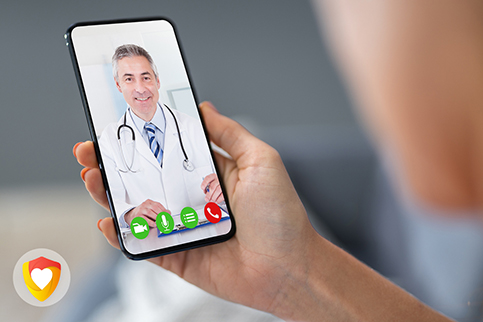Over the past few weeks, I’ve had the privilege of caring for hundreds of patients all across the country through Vituity’s teleurgent care program. With the COVID-19 pandemic racing toward its peak, many of these patients have nowhere else to turn. Even where in-person care may be available, people fear leaving home and exposing themselves and their families to this potentially deadly virus.
For patients isolated and desperate for care, telehealth has been a lifeline. I’ve received more thank-you’s in the last several weeks than I have in my entire in-person medical career. Rather than indicating that I’m not great at my in-person job, I suspect that people are feeling extra appreciative of care that we all used to take for granted.
Patients aren’t the only ones embracing virtual care. Suddenly telehealth, which has historically been underutilized, has emerged as a lifesaver for many health systems turning to virtual solutions to serve more patients while protecting the workforce and preserving personal protective equipment (PPE).
Our Vituity clients have always viewed us as a solution partner. When our hospitals, health systems, payers, providers, and patients face challenges, we’re willing to roll up our sleeves and work together to solve them. Over five years ago, we began building our Vituity telehealth program. This program now spans the care continuum, providing patients with expedited and safe access to expert care, inside and outside the hospital. In this article, I’ll share some of the ways we’re using telehealth to meet the challenges of this pandemic.
Teleurgent Care
With many physicians’ offices closed and urgent care clinics turning away patients with any hint of respiratory symptoms, Americans are requesting telehealth visits in record numbers. Vituity’s panel of acute care physicians is currently seeing thousands of patients each day.
The good news is that we’ve been able to manage the vast majority of patients very comfortably through telehealth. As an emergency physician, I’m accustomed to providing some primary care, but lately, it makes up a larger portion of my telehealth practice. Over the past several weeks, telehealth visits have led to diagnosing new onset diabetes as well as helping patients manage other chronic diseases such as hypertension, congestive heart failure (CHF), and chronic obstructive pulmonary disease (COPD).
Telehealth supporting in-person practices
Health systems are working hard to protect their workforce and expand capacity in the face of the pandemic. While PPE is extremely effective against COVID-19, many hospitals are concerned about limited supplies and conserving them. One way our Vituity practices accomplish this is by incorporating telehealth into emergency, inpatient, and critical care practices.
Many Vituity emergency departments (EDs) are leveraging telehealth technology to protect patients and staff from unnecessary exposures. For example, some innovative departments are using telehealth to safely triage patients in the waiting room, in outdoor tents, or even in their cars. Thanks to emergency waivers of the EMTALA mandate, we can now manage some stable ED patients mostly or entirely through telehealth. (Of course, we continue to provide in-person care to every patient who needs it.)
Inpatient units are also leveraging telehealth. As health systems work to expand ICU capacity and workforce, many are equipping these beds for remote management by off-site hospitalists and intensivists. Yet another advantage of telehealth is that it allows quarantined and work-restricted providers to see patients from their homes to which they are confined. This could be a lifesaver for patients and for hospitals that are short-staffed or experiencing surges in COVID-19 patients.
Future of telehealth
I believe we’re experiencing the type of black swan event that will change society and healthcare forever—much like 9/11 changed the way we view and manage air travel. What will healthcare look like post-COVID-19? I don’t know for certain, but it will most assuredly look different!
Telehealth is here to stay. One reason I expect to see more widespread use of telehealth is that many people are now trying it for the first time and realizing its benefits. They see firsthand how easy it is and how they can avoid the hassles of scheduling, driving through traffic to the doctor’s office, and potentially being exposed to others who are sick. Even if they’re not particularly tech savvy, they realize that today’s telehealth platforms are no harder to use than a cellphone.
My prediction is that the telehealth space will explode with possibilities—for patients and also for health systems, payers, and other stakeholders. Outpatient physicians might see fewer in-person visits but serve more patients via telehealth. EDs and urgent care clinics might experience fewer low-acuity visits as patients access care virtually. Convenience; cost-containment; and simple, timely access to healthcare providers could all be silver linings to this otherwise disastrous pandemic.























